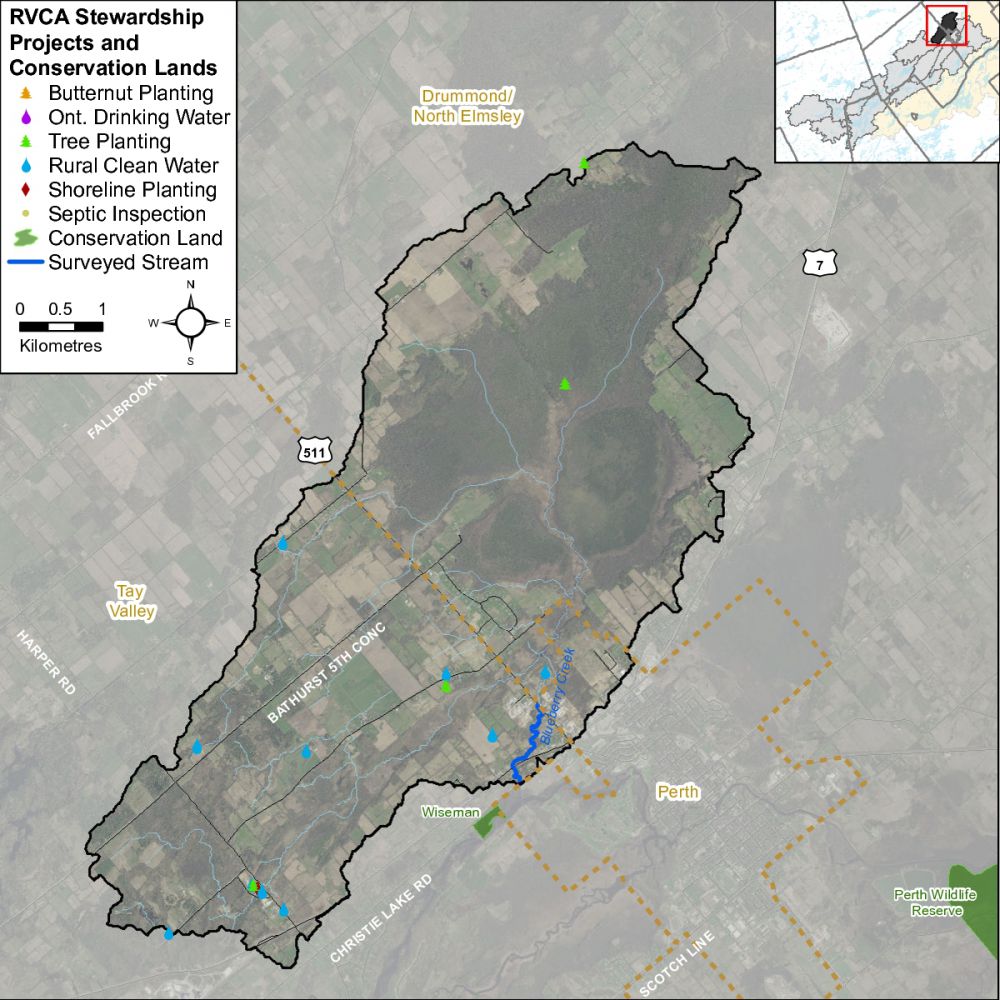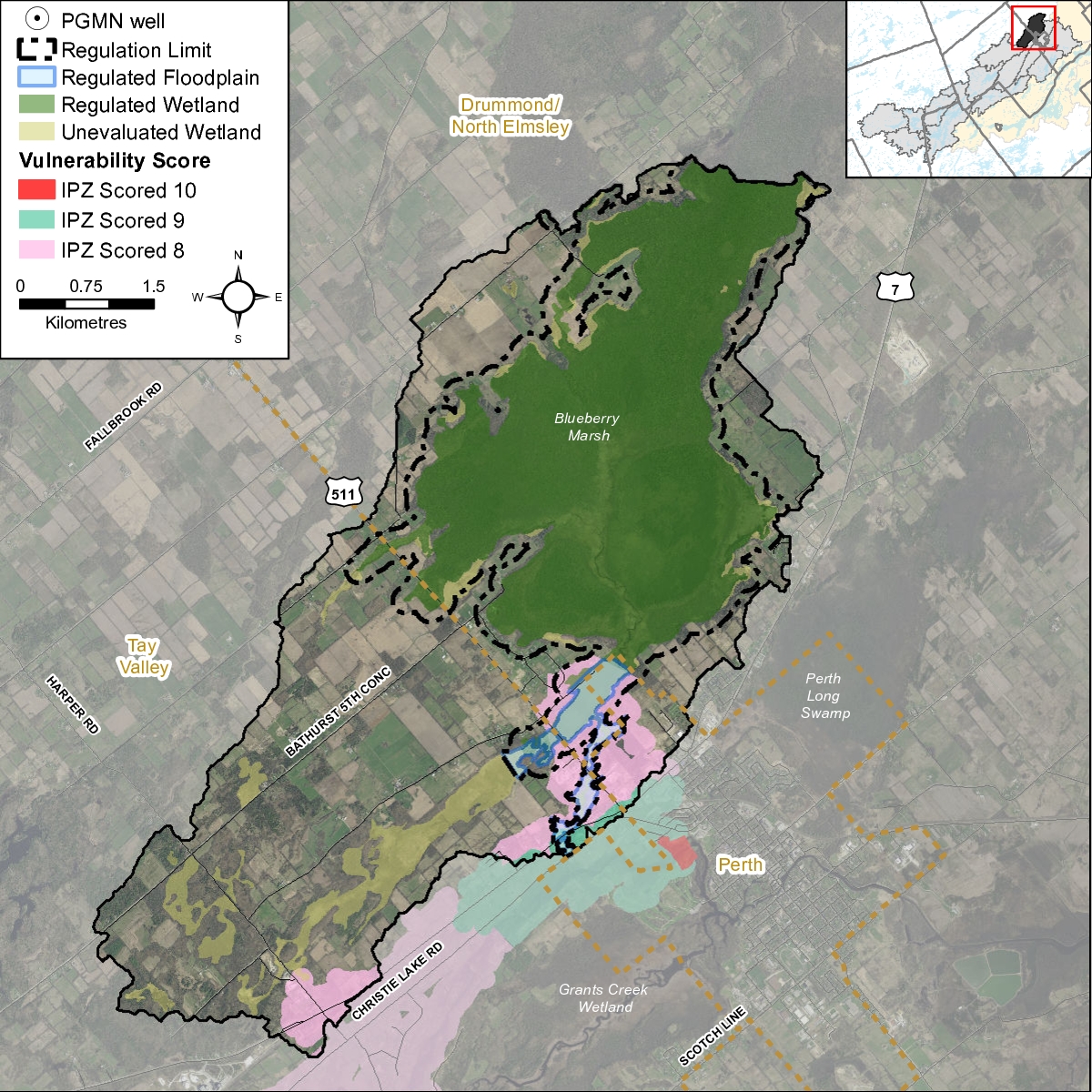5.0 Blueberry Creek Catchment: Stewardship and Water Resources Protection
The RVCA and its partners are working to protect and enhance environmental conditions in the Tay River Watershed. Figure 56 shows the location of all stewardship projects completed in the Blueberry Creek catchment.
5.1 Rural Clean Water
The Rural Clean Water Program provides technical and financial assistance to farmers and other rural landowners, to aid in the implementation of projects that protect water quality. Funding is granted to those projects that support best management practices for application in the protection and improvement of surface and ground water resources. The program also supports climate change adaptation and low impact development projects as well as educating rural landowners about environmental stewardship of private property. Examples of supported projects include livestock exclusion fencing, controlled tile drainage, cover crops, erosion control, well related projects, and many more. For a list of eligible projects and to apply for funding, see Rural Clean Water.
In the Blueberry Creek catchment from 2011 to 2016, one septic system repair, one well decommissioning, one well replacement, one well upgrade and one education initiative were completed; prior to this, three septic system repairs, three well upgrades, one well decommissioning, one livestock fencing project, one windbreak/buffer project and one education initiative had been completed. When combined, these projects are keeping 2.4 kilograms of Phosphorus out of our lakes, rivers and streams every year. Total value of all 15 projects is $72,414 with $18,661 of that amount funded through grant dollars from the RVCA.
5.2 Private Land Forestry
Forest cover and tree planting continues to be one of the most widely supported strategies to improve our environment. The many benefits of forest cover include carbon sequestration, flood mitigation and water quality improvement as well as providing wildlife habitat.
Through the RVCA's Trees for Tomorrow Program (and its predecessors), 2,000 trees were planted at one site from 2011 to 2016; prior to this, 1,800 trees were planted at four sites. In total, 3,800 trees have been planted resulting in the reforestation of two hectares. Total value of all five projects in the Blueberry Creek catchment is $9,532 with $7,354 of that amount coming from fundraising sources. For more information about the Program and landowner eligibility, please see the following: Tree Planting in the Rideau Valley Watershed and Trees for Tomorrow.
5.3 Shoreline Naturalization
Though the RVCA’s Shoreline Naturalization Program , landowners (private and public property owners) have naturalized more than 2.3 km of shoreline in the Tay Watershed by planting over 10,563 native trees and shrubs at 96 sites since 2008. In the Blueberry Creek Catchment, 73 native trees and shrubs have been planted along shoreline with a total project value of $1,168. In 2013, new trees, shrubs and wildflowers were added to the naturalization demonstration garden at the Tay Valley Township municipal office on Harper Road.
5.4 Valley, Stream, Wetland and Hazard Lands
The Blueberry Creek catchment covers 39.1 square kilometres with 17.4 square kilometres (or 44.4 percent) of the drainage area being within the regulation limit of Ontario Regulation 174/06 (Figure 57), giving protection to wetland areas and river or stream valleys that are affected by flooding and erosion hazards.
Wetlands occupy 15.6 square kilometres (or 39.8 percent) of the catchment. Of these wetlands, 13.2 square kilometres (or 84.6 percent) are designated as provincially significant and included within the RVCA regulation limit. This leaves the remaining 2.4 square kilometres (or 15.4 percent) of wetlands in the catchment outside the regulated area limit.
Of the 45.9 kilometres of stream in the catchment, regulation limit mapping has been plotted along 19.6 kilometers of streams (representing 42.7 percent of all streams in the catchment). Some of these regulated streams (14.6 km) flow through regulated wetlands; the remaining five kilometres of regulated streams are located outside of those wetlands. Plotting of the regulation limit on the remaining 26.3 kilometres (or 57.3 percent) of streams requires identification of flood and erosion hazards and valley systems.
Within those areas of the Blueberry Creek catchment subject to the regulation (limit), efforts (have been made and) continue through RVCA planning and regulations input and review to manage the impact of development (and other land management practices) in areas where “natural hazards” are associated with rivers, streams, valley lands and wetlands. For areas beyond the regulation limit, protection of the catchment’s watercourses is only provided through the “alteration to waterways” provision of the regulation.
5.5 Vulnerable Drinking Water Areas
The Town of Perth’s municipal drinking water Intake Protection Zone (IPZ), specifically IPZ-2 with a vulnerability score of 8 and 9 is found within the Blueberry Creek catchment (Figure 57). As per the Mississippi-Rideau Source Protection Plan, policies may affect future development within these areas. Under Section 59 of the Clean Water Act, 2006, future applications under the Building Code and the Planning Act may be screened by the Mississippi-Rideau Risk Management Office. Depending on the proposed activity, additional requirements or restrictions may apply. For more information, please contact the Mississippi-Rideau Risk Management Office at (613) 692-3571.
In addition, the Mississippi-Rideau Source Protection Plan has mapped the central part of the Blueberry Creek catchment as within a Significant Groundwater Recharge Area and identified all of the catchment as a Highly Vulnerable Aquifer. This means that the nature of the overburden (thin soils, fractured bedrock) does not provide a high level of protection for the underlying groundwater making the aquifer more vulnerable to contaminants released on the surface. Highly Vulnerable Aquifers characterise 89% of the Region and are considered moderate to low drinking water threats with certain policies that apply; mainly policies regarding waste disposal. All property owners are encouraged to use best management practices to protect sources of municipal drinking water. For more information on source protection best management practices, please visit Protecting Your Drinking Water.

